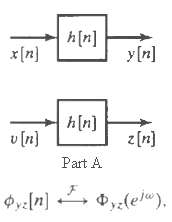Consider a linear time-invariant system whose impulse response is real and is given by h[n]. Suppose the
Question:
Consider a linear time-invariant system whose impulse response is real and is given by h[n]. Suppose the responses of the system to the two inputs x[n] and v[n] are, respectively, y[n] and z[n], as shown in Figure. The inputs x[n] and v[n] in the figure represent real zero-mean stationary random processes with auto correlation functions ?xx[n] and ?vv[n], cross-correlation function ?xv[n], power spectra ?xx(ej?) and ?vv(ej?), and cross power spectrum ?xv(ej?).

(a) Given ?xx[n],?vv[n], ?xv[n],?xx(ej?), ?vv(ej?), and ?xv(ej?), determine ?yz(ej?), the cross power spectrum of y[n] and z[n], where ?yz(ej?) is defined by
?with ?yz[n] = E{y[k]z[k ? n]}.
(b) Is the cross power spectrum ?xv(ej?) always nonnegative; i.e., is ?xv(ej?) ? 0 for all ?? Justify your answer.
Step by Step Answer:

Discrete Time Signal Processing
ISBN: 978-0137549207
2nd Edition
Authors: Alan V. Oppenheim, Rolan W. Schafer





